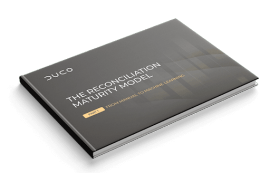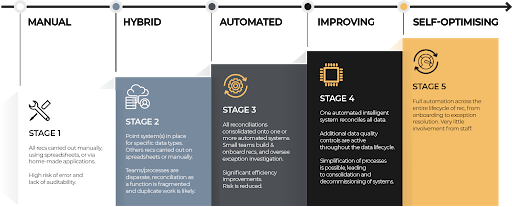Five steps that will change reconciliation forever
As we entered 2020, even before the global pandemic accelerated digitisation and changed the world for all of us, financial industry experts recognised that this would become the “decade of data“. Each and every day, our financial firms are inundated with trillions of lines of data from a multitude of sources.
The quantity and complexity of that data is increasing at such speed that it’s simply no longer realistic to rely on manual processes. It is not overstating the facts to say that only those firms properly equipped to deal with the influx of data will survive and thrive during this challenging decade.
And now, only a short way through this first year in the decade of data, our relationship with data must shift once more. For the world of finance, one of the many effects the Coronavirus crisis has had is to amplify the need for resilient, connected systems and more robust processes. With business continuity front of mind, many organisations are looking for more efficient ways to manage huge swathes of data from multiple, disparate sources quickly and accurately.
Ensuring ongoing data integrity is a key concern, and many are asking how they can automate their most critical processes – and the potential for machine learning technology to revolutionise how these processes are carried out.
Reconciliation is one of those mission critical processes; a control function that can protect firms from regulatory fines, financial loss, and in the worst case, failure of the entire business. But unfortunately, automation of reconciliation is, and always has been, a complex journey for many organisations. It’s something we – Duco – as a company, are working to help businesses overcome, and the reason we devised the Reconciliation Maturity Model (RMM).
The RMM draws on our experience of working on reconciliation best practices across a broad range of financial organisations from tier one banks and global asset managers, through to smaller hedge funds and corporates. It provides a practical and actionable roadmap in five steps for firms who would like to make the journey towards automation, consolidation and optimisation of their reconciliation processes, eventually arriving at a self-optimising model made possible by machine learning.
An overview of the RMM
So, what exactly are the five steps which could change reconciliation forever? These are outlined in depth in the RMM, which also contains an exploration of the obstacles to automation, along with practical advice on how to overcome them. It’s important to stress that this is a long-term model, which most organisations will join at step one or two.
In brief, the five steps to maturity look like this:
- Manual – all reconciliations are carried out manually, using spreadsheets, or via homemade applications. There is a high risk of error and lack of auditability.
- Hybrid – point system(s) are in place for specific data types, while other reconciliations are carried out on spreadsheets or manually. Teams/processes are disparate, reconciliation as a function is fragmented and duplicate work is likely.
- Automated – all reconciliations are consolidated onto automated systems. Small teams build and onboard reconciliations, and oversee exception investigation. There are significant efficiency improvements and risk is reduced.
- Improving – additional data quality controls are active throughout the data lifecycle. The simplification of processes is possible, leading to system decommissioning and consolidation.
- Self-optimising – full automation is deployed across the entire lifecycle of reconciliation, from onboarding to exception resolution, with very little involvement from staff. This is made possible via a machine learning enhanced system that can continuously adapt and improve based on the data it handles. Internal reconciliations are removed, leading to major reduction in cost and complexity.
Machine learning, when implemented properly, will enable firms to spot and correct data errors, inconsistencies and poor quality at source, before issues are created in downstream systems. Internal reconciliations are often used as “after-the-fact” control points in many financial institutions, but if data is fixed as it enters the organisation – by using machine learning technology that has trained on past data – these reconciliations will start to flag up fewer and fewer issues, and can be eventually be removed entirely.
Therefore, the ultimate aim of the RMM is to plot a course to an automated future where internal reconciliations become a thing of the past. This may seem some way off to organisations that remain heavily reliant on people power and unwieldy spreadsheets – but the RMM provides organisations with an opportunity to benchmark their progress and understand how other forward-thinking firms are taking action.
Larger strides towards maturity
Achieving larger strides towards reconciliation maturity is set to become increasingly important in the current environment, with data integrity, operational resilience and the elimination of risk becoming key business drivers. While automation and optimisation will never be an overnight process, access to expert advice and the availability of scalable, agile, machine-learning enabled technology should mean that every firm has what they need to start plotting their own course towards full maturity.
Most financial firms will agree that the vision of a future where internal reconciliations no longer exist – and where growth can happen unimpeded – is one they could really get behind. The RMM could be instrumental in helping more firms get there.
By Douglas Greenwell, reconciliation expert, Duco
Click here for a free download of the Reconciliation Maturity Model (RMM)













































